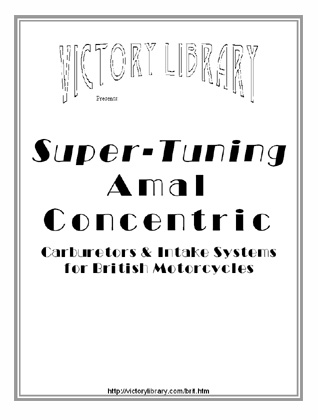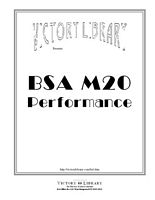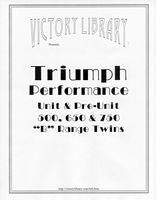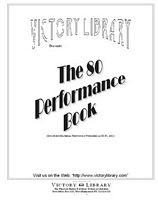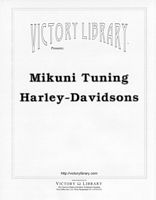

|
 |
Cam
Timing vs. Compression Analysis
The experienced engine builder (Harley-Davidson, Mopar, or Ferrari) knows that the “advertised” compression ratio (suggested by the owner’s manual, piston manufacturer, etc.) is only one of several factors involved in determining how much pressure is developed in the combustion chamber.
This article discusses briefly how to roughly calculate how changes in either cam timing, compression, or both affect low-speed torque and response. Some of the more important factors are: |
» |
Theoretical or mechanical compression ratio (“advertised”, or nominal), including
corrections made for changes in combustion chamber volume due to piston compression distance, valve
reliefs in piston dome, combustion chamber and/or bore, alternate gasket thickness, head, cylinder and/or case milling, etc. |
» |
Intake valve closing point (generally the 2nd number in the cam timing data, given in degrees after bottom
dead center, or ABDC) |
» |
Internal geometry of the motor |
This last factor is not fully appreciated by most mechanics. The crank-pin is offset from the sprocket & pinion shaft axis by exactly ½ the stroke length. The geometric relationship between the rod and the crank-pin is one not generally understood, but which plays a key role in the motor’s breathing and overall power characteristics.
The ratio of rod length to stroke length is almost always between 2.2:1 on the “long” end, and 1.4:1 on the “short” end. 99% of all motors fall between these 2 extreme limits, with most standard production designs between 2.0:1 and 1.5:1. |
The percentage of mixture captured, compressed, and burned in the cylinder at a specific point
of intake valve closure partially depends on the motor’s rod ratio. The piston’s motion during flywheel rotation is not symmetrical: the piston speed before & after TDC is faster than before & after BDC, but the difference is not constant - it varies with the rod ratio. Two motors with the same stroke, but different rod lengths, will not have the piston in the same place at the same point of flywheel rotation. The only 2 exceptions are 0° (TDC) where both strokes are zero, and 180° (BDC) where both strokes are equal & nominal.
The long-rod motor will have the piston closer to TDC than the short-rod motor at any point between 90° BTDC & 90° ATDC. The short-motor will have the piston closer to BDC than the long-rod motor at any point between 90° BBDC & 90° ABDC.
Short-rod motors (“n” = 1.5 to 1.7:1) have slower
piston movement upwards away from BDC on the compression stroke, and will capture
more mixture at the same point of intake valve closure. This makes them
more tolerant of extended (late intake closing) cam timing.
Longer duration cams generally need more static
compression. The usual cam functions (also known as valve events) are Intake
Opening Point, Intake Closing Point, Exhaust
Opening Point, Exhaust Closing Point, Overlap,
Lobe Separation Angle, and Valve Lift. The only one
which affects cylinder pressure directly is the Intake Closing Point - where the intake valve has just closed ABDC at the beginning of the compression
stroke. Intake valve closure after BDC (present in all modern cams) always
causes some of the intake mixture to be compressed backwards out of the
cylinder by the rising piston at very low speeds. Late (radical) intake
valve closure causes some mixture to escape even at moderate speeds, reducing
cylinder pressure during the operating range (at the lower end of the torque curve). The point in the engine’s RPM range where this reversion stops and full-stroke capture (or more!) occurs is frequently the torque peak, and depends on many factors, including cam timing, port efficiency, mixture velocity, manifold runner & port cross-sectional area & volume, etc. I have no method of applying math to these factors - too complex!
If you have (or plan to install) a long-duration cam, you can (and should) regain some of this lost pressure by raising the compression
ratio, but the 2 effects do not always “cancel each other out” -
you can't get something for nothing. Even though a higher compression ratio
will give you back a higher pressure gauge reading, the power may still
be lower, at least at low to moderate speeds.
The error lies in the fact that a smaller volume
of mixture being compressed to a higher ratio. Even though the pressure gauge reading taken during cranking or idling is higher, the total of cylinder pressure times the actual mixture volume
captured may still be lower (compared to the original milder cam and moderate
compression ratio).
As a note: the gas present in the combustion chamber @ TDC is presumed to be non-combustible exhaust gas remaining from the previous cycle, and is therefore not included in the mixture volume for our purposes. At high engine speeds (under certain conditions) overlap does cause this remainder to be partially combustible, but this is not true at cranking to moderate engine speed.
In short, a cam change can't be “cured” completely
by raising the compression ratio, but it’s still an excellent idea. The
“V/P Index” , which is the subject of this Tech Paper, will not predict
maximum torque or power, but still provides useful information about conditions present in the motor at cranking speed. These same conditions generally affects low-speed
response & flexibility, knock-resistance, etc. for spark advance settings, sprocket size choices, etc.
Another useful purpose is to anticipate the effect of higher elevation on cylinder pressure. Perform a calculation (as described below) first, then another substituting a lower value than 14.7 psi for “Atmospheric Pressure” . Compare the results to estimate how much adjustment to the nominal compression ratio is needed to (partially) compensate for the lower air density.
V/P Index
A reasonable estimate of the relative effects of
compression ratio, rod ratio, and intake valve closing point at cranking speed can be made
by use of a simple formula. Although a “power” (exponent) is used in the
formula, most pocket and on-line calculators have a function to permit
a fractional exponent to be entered (use Microsoft “Calculator” in Win95, etc. It has this feature - to use it, select “Scientific” view). Try it out - it’s
not that difficult!
Given: |
» |
Atmospheric pressure = 14.7 psi (pounds per square inch, or 29.92 inches of mercury). This is a constant for our purposes here at sea level, but should be adjusted downward for extreme elevations.
To convert psi to In. hg, multiply by 2.036; to convert In. hg to psi multiply by .0491. |
» |
Intake valve closing point (ABDC). At cranking speed, intake flow reversal still takes place until the valve
is actually closed, so the “paper duration” (nominal) closing point is
used for calculations. By the way, at operating speeds the general consensus is that the intake valve is effectively closed (the flow has stopped for practical purposes) at about .050” valve lift. |
» |
Theoretical compression ratio. Click here to review the factors, as described above:  . . |
» |
Stroke remaining at intake valve closing point, which is determined by the engine’s stroke, and rod to stroke ratio (“n” ). This is calculated by dividing the rod length by
the stroke length. To find the rod ratio of most Harley-Davidson engines, click here:  . . |
Results: |
» |
Corrected (true) compression ratio. |
» |
Cranking pressure, absolute (in psi, zero elevation std.). |
» |
Gauge pressure (in psi, zero elevation std.). |
» |
Corrected cylinder volume (cylinder displacement trapped when the intake valve closes). |
» |
V/P Index* |
*V/P (Volume/Pressure) Index is a mathematically-derived
figure, the product of the corrected volume and cranking pressure. It’s
a very useful barometer of the motor’s low-speed power, and may be solved
with new variables for a “before & after” analysis when modifications are
contemplated. Anyone planning a cam or compression ratio change would definitely want to know
how much the low-speed flexibility would be affected. Some useful insight may also be derived as to the motor’s tolerance of pump-quality gas (ping & knock resistance). The results of
these comparisons are generally quite surprising!
To calculate the V/P Index for a specific motor,
you'll need the exact piston position at all relevant flywheel positions from BDC to
about 90° ABDC, the compression ratio, and the intake valve closing point. |
If you'd like to calculate piston positions for your own motor, the following formula has been contributed by a reader: |
| SE = (S ÷ 2) + R + ((S ÷ 2) × cosA) - SQRT ((R2) - ((S ÷ 2) × sinA)2) |
where “SE” is the effective stroke, “S” is the nominal (full) stroke, “R” is the rod length, “A” is the crank-shaft angle in degrees ABDC from 0 to 90°, and “SQRT” (or “SQR” ) is the square root function.
Be sure to copy the equation very accurately, including the “nested” pairs of parentheses. This should work “as-is” for calculators, but most computer programs will require “A” to be converted from degrees to radians: Radians = Degrees × .017453, or Degrees × Pi ÷ 180. | To make a V/P Index calculation, find your intake closing point. Unfortunately, most cam manufacturers (including Andrews Products, Sifton, Leineweber, etc.) don't list nominal closing points in their specs - you might try to call them for this info (no, I don't have phone numbers, and I have no cam timing figures). Locate this figure as the flywheel position, and take the stroke from that position to calculate the “effective”
cylinder volume (“VE”), which is amount trapped
by the closed intake valve; which is always less than the nominal volume (“VN”).
Using this, calculate the effective compression ratio (“CRE” );
also lower - the combustion chamber volume is unchanged, but the cylinder
volume is less. At cranking speed, the absolute cranking pressure (“CP” )
is a function of the 1.25 power of the effective compression ratio (i.e.,
for 8:1 compression ratio, use 8^1.25)
times atmospheric pressure (14.7 psi @ sea level, etc.). This adjustment (1.25 power) is a polytropic value used in preference to the traditional adiabatic value (1.4) for the ratio of variable heats for air and similar gases at the temperatures present. This compensates
for the temperature rise caused by compression, as well as heat lost to the cylinder. 1.25 is not accurate in all cases, since the amount of heat lost will vary among engines based on design, size and materials used, but provides useful results for purposes of comparison.
To predict a pressure gauge reading subtract
14.7 (or the correct atmospheric pressure at test elevation) to compensate for the fact that a gauge in free air reads “0” , not
14.7 psi, even though atmospheric pressure is always present.
The V/P Index number
is the product of the effective volume times the effective compression
ratio, times the number of cylinders, times a correction factor weighted
to produce a number roughly proportionate to torque in ft./lbs. |
V/P = VE × CP
× N × .6%
Symbol |
Meaning |
Definition or Calculation |
B |
Bore |
Piston diameter, in inches |
S |
Stroke |
Full (nominal) flywheel stroke; TDC to BDC measurement (180° rotation),
in inches |
SE |
Stroke, Effective |
Stroke measured from intake valve closing point (less than 180°)
to TDC [always less than “S” , above] |
VN |
Cylinder Volume, Nominal |
B2 × S × .7854 (1 cylinder) |
VE |
Cylinder Volume, Effective |
B2 × SE × .7854 (1 cylinder)
[always less than “VN” , above] |
VC |
Chamber Volume |
VC = VN ÷ (CRN - 1). Total volume (1 chamber) above piston @
TDC, in inches. |
N |
Number of cylinders |
(2 in this case) |
AP |
Atmospheric Pressure |
14.7 psi @ sea level (zero elevation); use the correct lower figure for higher elevations |
CRN |
Compression Ratio, Nominal |
CRN = (VN + VC) ÷ VC |
CRE |
Compression Ratio, Effective |
CRE = (VE + VC) ÷ VC [always less than “CRN” , above] |
CP |
Cranking Pressure (absolute) |
CP = (CRE1.25 × AP) |
GP |
Gauge Pressure |
GP = (CRE1.25 × AP) - AP.
To predict gauge pressure, subtract atmospheric pressure (14.7 psi @ sea level, etc.) from absolute pressure. See above:  . . |
V/P |
Volume/Pressure Index |
V/P = CP × VE × N × .6% (.6% or .006 is a correction factor to return a useful 2 digit number proportionate to torque) |
Note: I have a Q-Basic program (your Windows 95/98/2000 PC already has it, probably in the “DOS” directory) to do all this annoying math automatically for any intake closing point, any compression ratio, etc., including reduction in atmospheric pressure for elevation. I can supply you with a copy of this program tailored to your own motor on disk for $10.00. E-mail me here for details: jdiamond@optonline.net for a copy. |
Panhead Calculation
For a base-line on a 74” panhead motor, let’s use the original 8.5:1 compression (4.9” or 81cc chamber volume), and make a guess at the intake
closing point of the original mild FLH cam at 55° ABDC. The effective stroke at this point is 3.302” , for an effective volume of 61.3” . The
effective compression ratio is 7.24:1. The effective pressure is 174 psi absolute (159 psi gauge pressure). The V/P Index is 64.
This explains the good torque on these motors, and why they require premium gas.
Let’s substitute a hotter cam with the intake closing point at 65° ABDC. The effective stroke at this point is 3.043” , for an effective volume of 56.5” . The effective compression ratio is 6.75:1. The effective pressure is 159 psi absolute (145 psi gauge pressure). The V/P Index is 54 - the cam change delayed the intake closing by only 10°
but reduced the cranking pressure by over 8%, and V/P Index by over 15% - this explains why such a big cam change softens the low-speed torque quite a bit, and reduces pinging.
Let’s increase the compression ratio to 9.5:1 (4.33” or 71cc chamber) with the same hot cam. The effective compression ratio is 7.52:1. The effective pressure is now higher than the original figure in the stock motor: 182 psi absolute (168 psi gauge pressure). This is not as effective as it may appear, as the high cylinder pressure may cause pinging, and 9.5:1 compression requires higher-domed pistons, which will restrict breathing somewhat during overlap. The motor will require re-balancing, head, cylinder & oil temperature will be higher, and life expectancy will be shorter. But did we get our power back? Not quite - the V/P Index gives you more of the picture: 61, still down over 4% compared to the stock motor, because the restored (higher) effective pressure is acting on reduced cylinder volume. Of course, as the RPM increases towards the torque peak, the percentage captured rises, and will eventually
reach and pass the effective pressure & volume of the stock cam at high speeds. |
U-Series Calculation
Let’s try a stock ULH (38 hp), with 5.7:1 compression (8.45” or 138.5cc chamber), and guess the intake closing (roughly) @ 45° ABDC. The stock rod is 7.90625” long.
The effective stroke is 3.801” , and an effective volume of 70.5” . The effective compression ratio is 5.17:1. The cranking pressure is 114
psi absolute (99 psi gauge pressure). The V/P Index is 48.
Let’s compare this with a hot U-Series motor: 4-3/4” stroker for 88” , and delay (increase) the intake closing to 65°. Compression is about 6.25:1 with the same combustion chamber volume. The effective stroke is 3.677” , and an effective volume of 68.3” . The effective compression ratio is 5.06:1. The cranking pressure is 111
psi absolute (96 psi gauge pressure). The V/P Index is 45. As you see, the size and compression ratio increases still don't bring the motor back up to the stock figure when the cam is this hot - the V/P is down more than 6%. |
|




